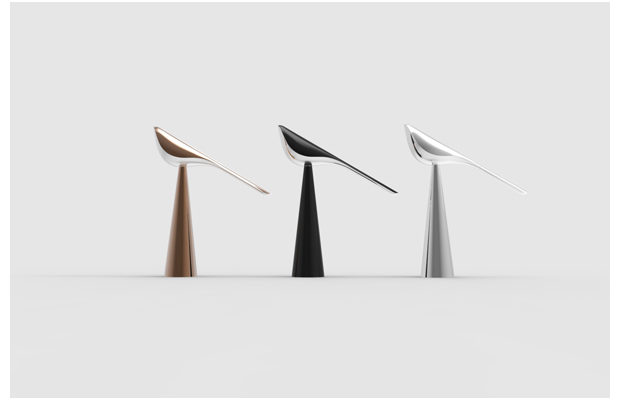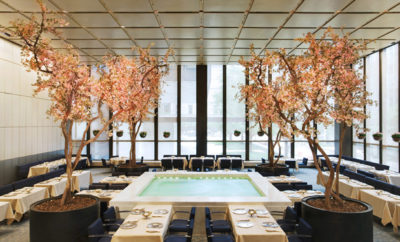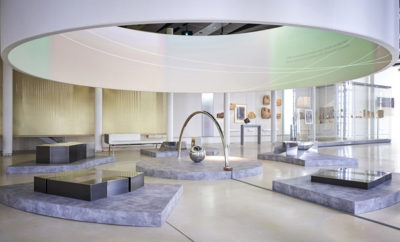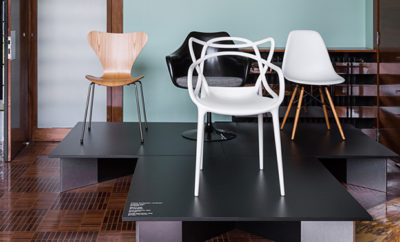
Design
Design’s Incubator
MILAN’S ANNUAL SHOWCASE OF YOUNG DESIGNERS SPOTLIGHTS EMERGING TALENT FROM AROUND THE GLOBE

Three chairs from Patrick Jouin’s 2013 Ester series in leather or fabric with bronze or black nickel legs. (Courtesy Patrick Jouin)
IN MANY WAYS, Marva Griffin Wilshire is the patron saint of young designers. Over the course of her many years in Milan—first as a journalist and later as part of the vast operation of Salone del Mobile— she observed that it was almost impossible for up- and-coming designers to connect with the producers of furniture, even (perhaps especially) during the furniture fair (this year’s runs from April 14 to 19). She wanted to “make a difference,” she says. The result was SaloneSatellite, a showcase for young designers now in its eighteenth year that has turned out to be the incubator of some amazing talent. To look at the list of names of Satellite discoveries is to see a who’s who not just of emerging talent, but of designers who are by now quite renowned.
Among them is the wildly successful Parisian designer Patrick Jouin. When Satellite was launched in 1998, he was working for Philippe Starck along with Matali Crasset, who “gave me the tip about this new show taking place in Milan.” Jouin jumped at the opportunity. “I did not have second thoughts,” he says. “In a minute I invested in the last booth available, and stacked into my little FIAT my FACTO Chair [now produced by Fermob], a rug, two lamps, and a coffee table. There was barely space enough for me in the car. I designed a huge sign with my name printed on it, and there I was.”

The seats of Herkner’s Banjooli chairs (2013/2014) for Moroso are hand-woven from the same thread used for fishing nets. (Courtesy Sebastian Herkner)
Likewise, it is almost legendary in design circles that Nendo was discovered at Satellite in 2003, just a year after the Canadian-born but Japanese- educated Oki Sato founded the firm. Oki Sato got a special mention at Satellite that year for the wildly innovative (yet always subtle and beautiful, if creatively named) work he showed—projects such as Streeterior, and Manhole-mat. That recognition led to further recognition, and almost immediately to other awards. Soon he had his first contract with such powerhouses as Giulio Cappellini and Maddelena De Padova. Since then, Nendo has enjoyed extraordinary recognition, including some three hundred commissions from some of the world’s top manufacturers. His limited edition work is sought after by collectors and enjoys success at auction, as well.
For the Indian-born, Dutch-based designer Satyendra Pakhalé, Satellite was not so much a beginning as an affirmation. “I think it was a continuation of the work that I was doing, making prototypes after prototypes and testing and trying ideas. Satellite has developed as an important international reference point, and Marva Griffin’s conception of giving a platform to young talents became an amazing success,” he says.

Satyendra Pakhalé’s lustrous green ceramic Flower Offering chair (2001), issued by BOSA in 2009. (Courtesy Satyendra Pakhalé/Amman Gallery)
Griffin Wilshire says she had “no dream, no ambition, just a desire to help young designers” when she launched Satellite. “In my almost eighteen years I have been in touch with almost ten thousand young designers and graduates-to-be from all over the world—more than forty countries. Quite a lot of them have made it, they are well known and pretty successful in the industry. For me it has been more than rewarding.”
Each year a distinguished jury looks at the participating designers’ work (last year there were almost seven hundred entrants, all under the age of thirty-five) to select winners in several categories, including what has become the prestigious Design Report Award. The first year the jury included Ross Lovegrove, Konstantin Grcic, and Crasset as well as Nasir Kassamali, founder of the Miami-based design showroom Luminaire. Kassamali says Satellite is “a great communications vehicle to transfer knowledge, collaborate and promote good design.” He points to such designers as Jan Plechác, who exhibited at SalonSatellite in 2011 and since then has “catapulted to great heights,” designing for Cappellini and other great manufacturers.”

Nao Tamura’s graceful Tiki desk lamp (2014) for Established & Sons is available in plexiglass, ceramic, or metal. (Courtesy Nao Tamura)
The Design Report honor has gone to such rising stars as the Brooklyn-based Nao Tamura (whose 2010 submission, called the Seasons plate, was subsequently produced by Covo, presaging her growing reputation) and Daniel Rybakken, a Norwegian lighting designer. Rybakken first showed at Satellite as a recent graduate and then returned three more times, the last of these—in 2011—with a special commission in honor of Salone’s fiftieth anniversary. The design team of Hanshi Chen and Shikai Tseng from Poetic Lab won the Design Report Award in 2013 for their Glass Ripple lamp, now produced by J. and L. Lobmeyr. “Their work continues to surprise me with its elegant simplicity and practicality,” says Kassamali.

Sebastian Herkner’s Bell coffee table features a brass top resting on a hand-blown glass base, upending notions of materiality. (Courtesy Herkner)
The German industrial designer Sebastian Herkner participated in Satellite in 2009, 2010, and 2011, each time offering a sampling of his work in furniture and lighting. Herkner typically melds tradition- al craft with new technology. From the start his work attracted the eye of major producers including ClassiCon, Gervasoni, and more recently, Moroso, which carries his Basks series. “On the last day of SaloneSatellite 2011, I met Patrizia Moroso,” he says, noting that she was attracted to a group of paper yarn baskets he had present- ed. “This was the starting point of our collaborations.”
The Brazilian designer Pedro Paulo Franco also showed at Satellite three times—in 2010 with his collection Artesania, in 2011 with a collection called Carnevale, and again in 2012 with two new chairs. Though, like others, his designs were acquired for production, after participating in Satellite he says that he “chose to develop my own brand with the collaboration of the most important designers in the world, such as Alessandro Mendini, Fabio Novembre, Nika Zupanc, Pininfarina, Campana Brothers. And my products also, of course.” As a result, his company, A Lot of Brasil, in now part of the main Salone.
Jouin also speaks of the contacts he made: “In a day I met Achille Castiglioni, Alessandro Mendini, Vico Magistretti, and Enzo Mari: all the greatest Italian designers,” he says. “It’s the first time I felt I was part of a community. It all began there.”

Jerri Hobdy’s gold-leafed iron and glass Elegant Etagere for Wisteria will be released this spring. (Courtesy Jerri Hobdy/Wisteria)
And for many aspiring designers, it is still a beginning. “It was truly a humbling and glorious experience,” says Jerri Hobdy, who last year was the youngest American represented at SaloneSatellite as part of a team from the Savannah College of Art and Design. “SaloneSatellite is the best thing that has happened to me as a young designer. Not only has a majority of my press come from my attendance and participation in the show, but I grew my network exponentially in the week I was there,” she says. “I still keep in touch with some of the most brilliant young designers that I met at that show that live all over the world. As a young, emerging designer, what is lovelier than connecting and building meaningful relationships with people that share a passion for fresh, original design?”












